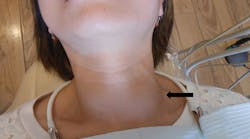Dental professionals and screening for primary hyperparathyroidism (PHPT)
If you conduct a routine head and neck evaluation and notice swelling around the parathyroid glands of a patient, what do you suspect is going on? If this same patient presented with osteoporosis on their medical history, would you make a correlation?
The parathyroid glands are two pea-sized glands that rest behind the thyroid gland and are responsible for producing parathyroid hormone (PTH).1 The role of this hormone is to keep blood calcium levels from going too low by releasing calcium from the bones. In instances where PTH overreacts, too much calcium is released from the bones, causing a spike in blood calcium.1
Various symptoms and comorbidities may result from a primary hyperparathyroidism diagnosis, but as oral health-care providers, we can be vigilant in bringing awareness to the warning signs. Here I review the current literature on primary hyperparathyroidism (PHPT), along with signs, symptoms, and the role of oral health-care providers in advising patients to seek care.
Overview of PHPT
PHPT is the third most common endocrine disorder behind diabetes mellitus and hypothyroidism and is most prevalent in postmenopausal women.2 In 80% of cases, PHPT is attributed to benign parathyroid adenoma, which is what you may detect on a head and neck evaluation. In 15%–20% of cases, it could be a multigland disorder, meaning multiple adenomas or multigland hyperplasia.
In rare cases, PHPT is a result of parathyroid carcinoma.2 Routine bloodwork may also indicate elevated levels of blood calcium, however, patients with mild cases are typically asymptomatic prior to their diagnosis. For patients in later stage PHPT who are symptomatic, signs can include constipation, frequent urination, increased thirst, joint pain, kidney pain, lethargy, fatigue, loss of appetite, and muscle weakness.1,3
When PTH overreacts, calcium is pulled from the bones into the blood. When too much calcium is available in the blood, it goes into the kidneys and filters through the urine, resulting in kidney stones.4 Research shows that 10%–20% of patients with PHPT present with kidney stone disease, also known as urolithiasis.1 The symptoms of PHPT are somewhat vague and may not lead a provider to suspect PHPT, but leaving this condition undiagnosed can lead to long-term health complications and risks for early mortality.
PHPT and quality of life
In cases of PHPT, PTH is being produced at an elevated rate, which results in more calcium being pulled from the bones than is needed by the body. When bones release calcium, they go through a process called bone turnover. This is essentially how the bones maintain homeostasis of calcium when it is lost: the bones resorb and then become replaced.
In patients with PHPT, this high rate of bone turnover leads to a higher rate of bone loss over time, specifically cortical bone.1,2 The gradual loss of cortical bone results in osteopenia or osteoporosis, placing patients at much higher risk for bone fractures, even with minimal trauma. Bone fractures are a common comorbidity with PHPT, and should be taken into serious consideration when evaluating someone for surgery.4
A recent meta-analysis was conducted to measure the risk of fracture in patients with PHPT in comparison to a healthy control population. Statistically significant results indicated the risk of total fracture, including vertebral and nonvertebral fractures, was higher among patients with PHPT compared to the control population.3 This same study also compared bone mineral density (BMD) of patients with PHPT to healthy controls.
Statistically significant results concluded that the risk of vertebral fracture was higher among symptomatic patients with PHPT compared to the healthy control population.3 These risk factors can alter quality of life and are correlated with excess morbidity and higher rates of premature mortality.2
The best treatment option for this condition is a parathyroidectomy, however, many instances involve simple nonoperative observation. The rationale behind a parathyroidectomy is to increase BMD, and while several studies have shown positive results after treatment, further longitudinal studies must be completed to make a definitive correlation between surgery and long-term results.5
A 10-year randomized controlled trial compared PHPT patients who underwent a parathyroidectomy to those with PHPT who were observed without surgery. The parathyroidectomy yielded statistically significant results over nonobservation regarding BMD.5 The results of this study show that positive outcomes from a parathyroidectomy compared to observation improved BMD over time.
Role of the oral health practitioner
PHPT is more prevalent in developing countries where routine biochemical screening is not practiced and there is frequent vitamin D deficiency.3 Although PHPT affects a very small portion of patients in western cultures, it’s imperative to be aware of warning signs that may present on a patient’s medical history or head and neck evaluation.
For patients over the age of 50 with osteoporosis, the oral health-care practitioner should inquire if they have yearly evaluations to check their blood calcium and parathyroid hormone levels, as it is well understood that osteoporosis can be a result of PHPT. Routine bloodwork suggested by the oral health-care provider, whom the patient may be seeing more frequently than their primary care provider or endocrinologist, could be life-altering for a patient who has underlying PHPT.
A comprehensive head and neck evaluation at every appointment will also allow the oral health practitioner to screen for any potential swelling or tumors around the thyroid and parathyroid glands. Should any areas be identified, it’s the responsibility of the provider to make the appropriate referral.
PHPT is not frequently diagnosed but if left untreated could result in numerous risk factors and lead to a higher mortality rate. Bringing the “why” back into head and neck evaluations can help us connect the dots for patients in their medical histories.
Drawing correlations between osteoporosis, osteopenia, and PHPT could be a new concept to many patients and providers. As oral health-care providers, it is our obligation to take a detailed look into patients’ medical histories beyond updating medications and allergies. Bringing these conversations into the operatory will assist patients in achieving true oral-systemic health.
References
1. Primary hyperparathyroidism. Johns Hopkins Medicine. Accessed May 10, 2024. https://www.hopkinsmedicine.org/health/conditions-and-diseases/primary-hyperparathyroidism
2. Pappachan JM, Lahart IM, Viswanath AK, et al. Parathyroidectomy for adults with primary hyperparathyroidism. Cochrane Database Syst Rev. 2023;3(3):1-77. doi:10.1002/14651858.CD013035.pub2
3. Narayana N, Palui R, Merugu C, et al. The risk of fractures in primary hyperparathyroidism: a meta-analysis. J Bone Miner Res. 2021;5(4):1-9. doi:10.1002/jbm4.10482
4. Primary hyperparathyroidism. National Institute of Diabetes and Digestive and Kidney Diseases. Accessed May 10, 2024. https://www.niddk.nih.gov/health-information/endocrine-diseases/primary-hyperparathyroidism
5. Lundstam K, Pretorius M, Bollersley J, et al. Positive effect of parathyroidectomy compared to observation on BMD in a randomized controlled trial of mild primary hyperparathyroidism. J Bone Miner Res. 2023;38(3):372-380. doi:10.1002/jbmr.4763
About the Author

Annie Walters, MS, RDH
Annie Walters, MSDH, RDH, has extensive experience as an oral health-care provider. She has spent time caring for individuals in Guatemala and Indian Health Service sites and is passionate about advancing access to care for individuals with specialized health care needs. She is a published author and is trained in Orofacial Myofunctional Therapy. Annie received her graduate degree from the University of New Mexico and currently serves as an assistant clinical professor at Northern Arizona University. Reach her at [email protected].


